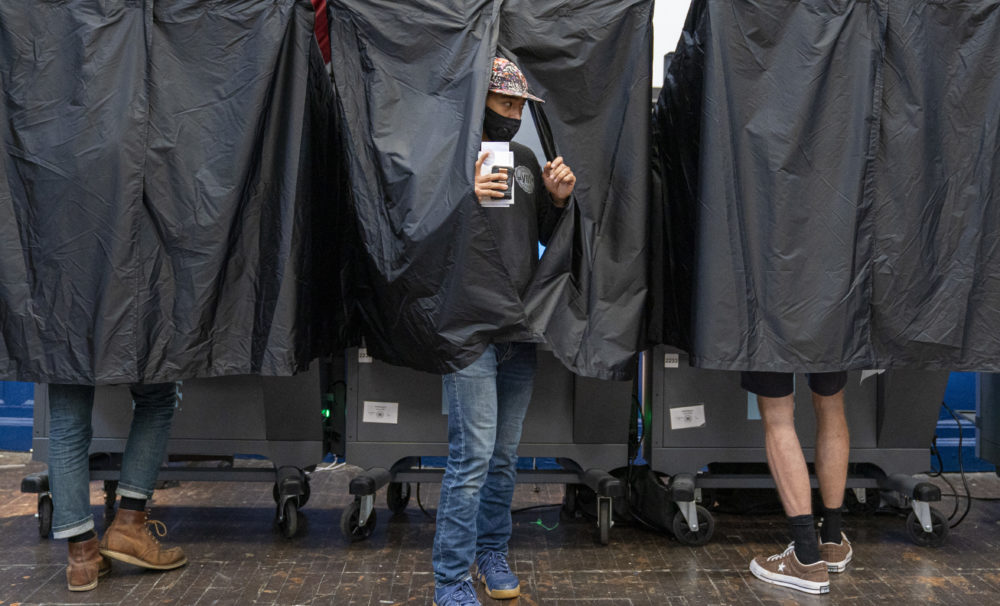
WASHINGTON — The United States and China could announce a limited trade agreement this week that would prevent President Trump’s planned tariff increase from going into effect this month and set rules around how China manages its currency, according to a U.S. Chamber of Commerce official who has been briefed by both negotiating teams.
Top officials from the two countries are meeting again this week to try to resolve a yearlong trade war that has dragged on amid disagreements over the types of provisions any pact should include. But as the clash begins to inflict economic pain on the global economy, negotiators from both sides seem increasingly focused on reaching a mini-deal that would resolve just a portion of the trade dispute.
Myron Brilliant, the executive vice president and head of international affairs at the Chamber of Commerce, told reporters on Thursday that he was “hopeful” that a limited arrangement stopping a planned tariff increase on Oct. 15 would emerge from this week’s meetings.
Mr. Brilliant, who recently spoke with both negotiating teams, added that a more comprehensive pact could be announced this week but that the scope of the deal would depend on what Chinese negotiators brought to the table. The Trump administration could also contemplate removing the threat of additional tariffs that are scheduled to be imposed in December or roll back some of the tariffs it has already levied on more than $360 billion of Chinese goods based on the package of offers brought by the Chinese negotiating team, he said.
Such a limited arrangement would not constitute a full resolution and is unlikely to satisfy Mr. Trump’s demands that China change many of its economic practices, such as limiting state subsidies to its firms. The deal appears likely to repackage concessions that China has made to the United States in previous months and years — including an agreement reached on currency this year, before a falling-out between the countries in May brought progress to a standstill.
Still, a limited deal — which Washington officials have begun referring to as an “early harvest” or a “confidence building” measure — could lower tensions between the United States and China and help to mitigate some of the damage that tariffs and other punitive measures have begun to take on companies on both sides of the fight. Considerations of a limited deal involving currency promises were first reported by Bloomberg.
Mr. Trump said on Twitter on Thursday morning that he planned to meet China’s top trade envoy, Liu He, on Friday, raising speculation that a more limited deal might be at hand.
“Big day of negotiations with China,” the president wrote. “They want to make a deal, but do I? I meet with the Vice Premier tomorrow at The White House.”
The trade meetings come amid a growing recognition on both sides that the bilateral relationship has been headed in a troubling direction. Trade between the United States and China has slumped, dragging on both economies. In the United States, uncertainty about the prospect for future tariffs has discouraged businesses from making new hires and investments, an unwelcome development at a time of gathering economic gloom.
“We can’t afford a further escalation of the trade war that will only accelerate the chance of a recession,” Mr. Brilliant said. “I am confident the U.S. administration understands the stakes here on that front.”
Administration officials have denied that they are seeking any kind of “partial” or “interim” deal. Yet people familiar with their thinking say many are open to the possibility of an arrangement that would roll back some tariffs in return for Chinese agricultural purchases, stronger protections on intellectual property or other concessions.
But they caution that it is unclear whether the president will ultimately agree to such an arrangement. Mr. Trump and his advisers are wary of being criticized by both Democrats and Republicans for making a deal that is too weak and giving up the leverage Mr. Trump has created with his tariffs.
Announcing some kind of package of concessions this week might pave the way for a larger trade deal when Mr. Trump is next expected to meet President Xi Jinping of China in person, in November at the Asia-Pacific Economic Cooperation meetings in Santiago, Chile, Mr. Brilliant said.
Other trade experts expressed support for a positive turn in relations, regardless of what an agreement would be labeled.
“On eve of China trade talks, I welcome both sides making sufficient progress to forestall future tariff hikes and even some rollbacks,” Wendy Cutler, a vice president at the Asia Society Policy Institute and a chief trade negotiator for the Obama administration, tweeted on Wednesday. “Some call this a partial deal — but i call it announcements of tangible progress that gives momentum to the overall talks.”
It is unclear whether the provisions that might be announced this week would be new, or how much they might change China’s economic actions.
In meetings in February, China and the United States agreed to avoid devaluing their currency to make their products cheaper abroad and give their exporters an advantage, Chinese officials said in March. They also agreed to continue to comply with previous currency agreements among the Group of 20 countries, and disclose detailed information in accordance with standards set by the International Monetary Fund.
But this and other agreements were put off in late April, when the Chinese changed the draft trade agreement and American officials accused them of reneging on a pact that was nearly complete. Since then, relations have steadily worsened. In August, the Treasury Department formally labeled China a currency manipulator after Beijing allowed its currency to weaken — a decline that many economists said was done in line with market forces.
Since then, both sides have brandished a series of carrots and sticks in an attempt to pressure each other into a favorable deal. China resumed buying American agricultural goods last month, after ceasing its purchases to put more pressure on American farmers. Chinese officials also quietly dropped earlier public demands that any deal must immediately get rid of all of Mr. Trump’s levies, paving the way for a potential interim agreement.
Mr. Trump said last month that he would delay a round of tariff increases from Oct. 1 to Oct. 15. Last week, he gave a green light for his administration to issue some licenses allowing American companies to supply goods to the Chinese telecom firm Huawei, which he previously put on a blacklist barring it from buying American goods.
But other interim measures have ratcheted up the tension. The Trump administration announced on Monday that it would add 28 more entities to that blacklist, including some of China’s leading artificial intelligence firms. On Tuesday, the State Department announced visa restrictions for Chinese officials accused of involvement in human rights abuses.
Many uncertainties remain in the trade talks. In particular, China has appeared unwilling to make many of the more significant changes to its economy that the Trump administration has demanded, including restraining its subsidies to state-owned firms and allowing for the flow of data across its borders.
Mr. Brilliant said on Thursday that China’s promises on intellectual property still revolved around “20th century” issues, like copyrights for movies and software, rather than “21st century” issues involving the use of data. He said that while there could be an announcement on intellectual property this week, it appeared that more fundamental concerns about China’s treatment of technology would not be addressed.
Keith Bradsher contributed reporting from Hong Kong.
Follow Ana Swanson on Twitter: @AnaSwanson.
Get politics and Washington news updates via Facebook, Twitter and the Morning Briefing newsletter.


